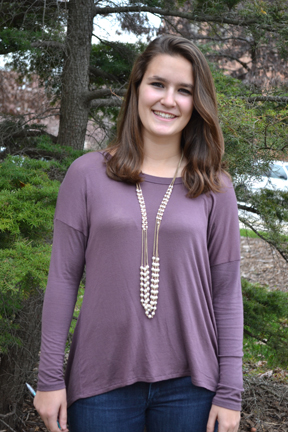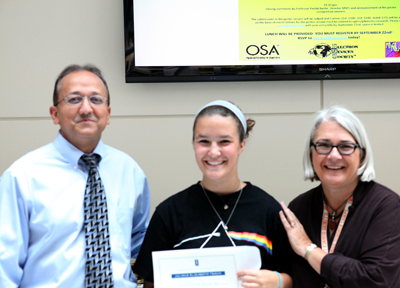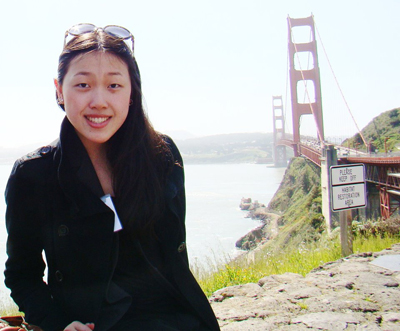EBICS Offers High Schoolers Research at the Intersection of Biology & Engineering

Juliana Trach, local high school senior who participated in EBICS' High School Research Program during summer 2012.
November 27, 2012
In summer 2012, three high school students had the opportunity to participate in authentic summer research opportunities at the intersection of biology and engineering. Sponsored by EBICS (Emergent Behaviors of Integrated Cellular Systems), these students participated in its High School Research Program, which seeks to increase the number of students who choose careers in the discipline by exposing high school students (especially those underrepresented in STEM fields) to research opportunities in the new discipline. An NSF Science and Technology Center, EBICS is located at Illinois and other institutions of higher education, including Georgia Tech and MIT. Its education mission, to "develop innovative education, outreach, and training programs across EBICS that will prepare students to become future researchers and education leaders in the new discipline," is designed to support its overall mission: "to create a new scientific discipline for building living, multi-cellular machines that solve real-world problems in health, security, and the environment."
Why does EBICS have research experiences for high school students as part of its education component? According to Lizanne DeStefano, I-STEM Director and EBICS Director of Education, "We find that, particularly in the field of engineering, many high school students do not come in contact with engineering coursework or engineering experiences. They have biology; they have chemistry; they have mathematics; they have physics, but they don't really have a chance to explore engineering. So we feel that bringing high school students into engineering labs and exposing them to engineering content helps them see whether they have an interest in engineering and also helps them make connections between the coursework that they do have—physics, mathematics, chemistry—and engineering concepts."
One of the three students who participated in EBICS' program this past summer, Juliana Trach, is currently a senior at University Laboratory High School in Urbana. As part of her internship under Rashid Bashir, she attended attend Illinois' two-week-long BioSensing BioActuation BioNanotechnology Summer Institute 2012.
As intended, Trach's experience at the Institute helped to give her direction regarding her future career choice. The experience not only helped to narrow down the type of research that interests her, but showed her the kind of research she doesn't want to do. "It was really interesting, because for a long time I thought that I wanted to do either bio or chemistry, and so I thought that something like Biosensing would be interesting, so I went…because I was thinking more the chemistry side of neuroscience. But being there, it kind of pushed me toward the more behavioral biology side. So it gave me perspective on what I wanted to do."
The experience also reaffirmed Trach's intention to pursue interdisciplinary research: "It was interesting to work in an interdisciplinary thing, because that's what I want to do. I want to do neuroscience. I learned that I definitely need a human aspect in my research. But I also learned that the interdisciplinary collaboration is something that is really interesting to me. I would want to be in a lab. I just need a more human aspect to the research."

Rashid Bashir (left) and Lizanne DeStefano (right) award Juliana Trach a certificate for her participation in the B3 Summer Insititute (photograph courtesy Obaid Sarvana).
Trach's immersion in a research lab environment during the lab exercises, including exposure to experts in their fields, also helped to confirm that regarding her college education, she sees working in a research lab in her future. "It also made me really sure that I want to work in a lab; I want to go somewhere where I can have the opportunity to work with professors in a lab, because it was just really interesting. You learn so much more when you have the opportunity to work with peers as well as work with people who've been doing what they've been doing for a long time."
Although she was the only high school student to attend the B3 Summer Institute, Trach found the event to be positive and even did some networking. "At first, I was a little nervous just because everyone was so much older than me. There weren't even that many undergrad students; it was mostly grad students. But I really didn't have trouble at all. Everyone was super nice, and I actually made friends really easily, and I still talk to some of them. I wasn't intimidated; I was comfortable. It was fun."

Michelle Long, high school senior who participated in EBICS' High School Research Program during summer 2012 (photograph courtesy Michelle Long)
Michelle Long, also a current high school senior, was at MIT both this past summer, as well as the previous summer, working with MIT Professor Ron Weiss and graduate student Adrian Slusarczyk. Using the heirarchical cloning methods utilized at the Weiss Lab, Long helped design and construct synthetic gene circuits. Researchers hope to form synthetic microtissues based on the data these circuits generate.
Long reports that the experience gave her the opportunity to apply what she has learned to real research: "I was finally able to apply the biology and mathematics I learn in school to research in fields that I am passionate about. I learned how to approach scientific questions through designing and conducting an engineering project."
As a result of her participation in the program, Long intends to study bioengineering at the next level: "It helped to solidify and clarify my preexisting interests in bioengineering and synthetic biology. I hope to study bioengineering and tissue engineering, specifically, in college."
According to Long, her exposure to authentic research in a laboratory setting was an invaluable educational experience: "What I found to be most valuable was being thrown into the lab work and asked to learn through my struggles and incomprehension. I learned the most by being forced to discover problems and come up with possible solutions through experience."
Semon Rezchikov, who is from New Jersey, also worked in the Weiss lab at MIT this past summer. Mentored by grad student Slusarczyk and postdoc Jonathan Babb, Rezchikov developed a 3D computational model that simulates cells which contain synthetic genes moving around, changing, and interacting with one another. According to Rezchikov, the model he built is more than a hundred times faster than other existing models and uses techniques like differential adhesion and cell-to-cell signaling to build mammalian multicellular systems that can form patterns based on genetic information encoded into them.
Rezchikov found the summer research program to be extremely beneficial personally: "I learned a lot of things about computational modeling, created a cool piece of software that may be used by many other researchers, and got to interact with brilliant people."
Rezchikov is not sure whether the EBICS program impacted his future career choice or field of study: "I was already interested in the potential of synthetic biology before the summer program. So I suppose that no, it just furthered my preexisting convictions."
Would Rezchikov recommend the program to other high school students as a way of discovering what research is really like? Definitely. "Doing research is an excellent way to gain a lot of depth and understand the mindset necessary to accomplish real things, which is a mindset that is not necessarily taught in school. In research, there are a lot fewer rules and a lot fewer certainties. It's exhilarating, in a way." His succinct description of the experience: "I learned a lot, worked really hard, and had a lot of fun!"
Was the high school research component this summer successful? DeStefano believes so. "It was very small scale this year. We had only three students participating, because there's always the question in the mind of faculty, 'What can a high school student really do in a lab in a fairly short period of time?' So this was kind of a proof of concept that students can come into a lab in the summer and really learn a lot and can contribute to the lab. So I would say, yes, as a proof of concept it was very successful, and I think it's something that we plan to continue and possibly even expand in the future."
Story and photographs by Elizabeth Innes, Communications Specialist, I-STEM Education Initiative
More: 8-12 Outreach, EBICS, High School Research, Summer Research, 2012













.jpg)
















